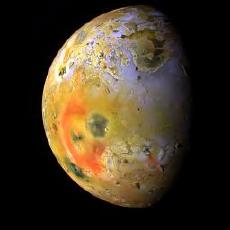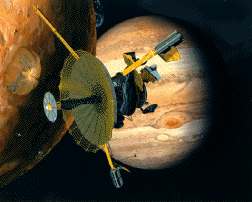Io
 Orbiting
the giant planet Jupiter is the fascinating moon, Io, one of
four moons discovered by Galileo in 1610. One look at Io and
it is obvious that something unusual is going on there. Its
mottled surface is a collage of colors-yellow, orange, red,
and blackish browns - which make it look somewhat like a
gigantic pizza. The explanation for this remarkable color
palette is found down on the surface. Volcanoes! Io is
literally bursting with volcanic activity. Volcanoes spew
out vast amounts of sulfurous material which cover Io's
Iandscape. Io's surface coloration reflects the various
colors that sulfur takes on at different
temperatures.
Orbiting
the giant planet Jupiter is the fascinating moon, Io, one of
four moons discovered by Galileo in 1610. One look at Io and
it is obvious that something unusual is going on there. Its
mottled surface is a collage of colors-yellow, orange, red,
and blackish browns - which make it look somewhat like a
gigantic pizza. The explanation for this remarkable color
palette is found down on the surface. Volcanoes! Io is
literally bursting with volcanic activity. Volcanoes spew
out vast amounts of sulfurous material which cover Io's
Iandscape. Io's surface coloration reflects the various
colors that sulfur takes on at different
temperatures.
Fiery volcanoes pepper Io's landscape, and massive lava flows spread out over enormous distances. From its surface, geyserlike eruptions eject dust and gas hundreds of kilometers into space, which fall back to the ground in elegant umbrella-shaped plumes. Some of the hottest temperatures in the solar system outside of the sun are found here, and yet most of the surface is bitterly cold.
 Intense
radiation from Jupiter's atmosphere over the course of the
mission has severely damaged Galileo's computer circuitry
and has resulted in failure of the spacecrafts computer
systems. In order to prevent the possibility of the crippled
spacecraft contaminating the environment of Io's neighboring
moon, Europa, which may harbor a liquid water ocean beneath
its surface, the spacecraft will plunge into the atmosphere
of Jupiter on September 21, 2003. At that time, after a
tremendously successful eight year tour of the Jovian
system, the Galileo mission will come to an end.
Intense
radiation from Jupiter's atmosphere over the course of the
mission has severely damaged Galileo's computer circuitry
and has resulted in failure of the spacecrafts computer
systems. In order to prevent the possibility of the crippled
spacecraft contaminating the environment of Io's neighboring
moon, Europa, which may harbor a liquid water ocean beneath
its surface, the spacecraft will plunge into the atmosphere
of Jupiter on September 21, 2003. At that time, after a
tremendously successful eight year tour of the Jovian
system, the Galileo mission will come to an end.
Photo Credit: NASA/JPL
Illustration Credit: NASA/JPL
Sign
My Guestbook
![]() View
My Guestbook
View
My Guestbook
© 2003
Janet
Stuhr Wood
All rights reserved.
webmaster@planetaryexploration.net
Date created June 6, 2000
Last updated June 5, 2003